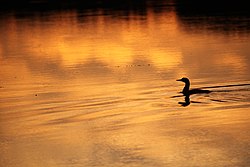| Horn River | |
|---|---|
 A common loon on the Horn River at sunrise | |
 | |
| Location | |
| Country | Canada |
| Territory | Northwest Territories |
| Physical characteristics | |
| Source | |
| • coordinates | 62°44′N119°38′W / 62.73°N 119.63°W |
| • elevation | 240 m (790 ft) |
| Mouth | |
• location | Mackenzie River |
• coordinates | 61°28′36″N118°04′51″W / 61.47665°N 118.08075°W |
• elevation | 150 m (490 ft) |
The Horn River is a river in the Northwest Territories of Canada. It is a major tributary of the Mackenzie River. [1]
Contents
The river gives the name to the Horn River Formation, a shale deposit of the Western Canadian Sedimentary Basin. The Horn River Basin refers to the extent of the Horn River Formation in the subsurface, and is not defined by the Horn River watershed.